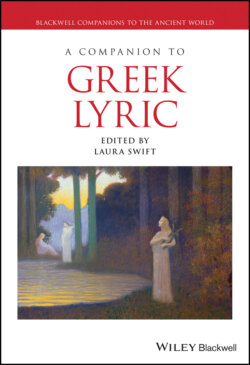Читать книгу A Companion to Greek Lyric - Группа авторов - Страница 12
CHAPTER 1 The Lyric Chorus
ОглавлениеLucia Athanassaki
The chorus was a group of male, female, or male and female adults, adolescents, or children who sang and danced simultaneously in honor of the gods at periodic Panhellenic and local festivals or smaller cultic events.1 Choruses also celebrated in song and dance important moments and achievements of mortals, such as weddings, athletic victories, civic and religious appointments, and any other activity that a community or a family thought worth celebrating and/or commemorating. Even when choruses celebrated human achievements, however, gods enjoyed an equal, if not greater, share in the eulogy, because divine favor was considered a sine qua non for human success and poets were well aware of the divine wrath and punishment awaiting those who did not pay them proper tribute.2
Traditional songs were available for the wide range of cultic and social occasions, but the great number and variety of Panhellenic and local occasions in the metropolitan and colonial Greek world, the agonistic spirit, and the prosperity of Greek cities during the archaic and early classical period gave rise to a booming song culture that fostered great artistry, creativity, and innovation.3 The Panhellenic and high-profile local festivals were the venues where poets had the opportunity to display their talent and choruses their virtuosity. Like poets, choruses also traveled to Panhellenic and other major sanctuaries for theoric purposes,4 but these also had their own resident choruses, often female. The Homeric Hymn to Apollo offers a precious early testimony of such a chorus on Delos, the famous Deliades, who are also epigraphically attested.5
The gender and number of choreuts6 varied according to the occasion, the honorand, and in all likelihood the region. Apollo, for instance, was worshipped by male, female, and mixed choruses in Delphi, Athens, Delos, and elsewhere.7 Similarly, male choruses performed dithyrambs for Dionysus in Athens, whereas the god is frequently imagined as leading his female Bacchic choruses in Thebes and Delphi. Whereas Attic drama initially required 12 and later 15 choreuts for tragedy and 24 for comedy, the number of choreuts that performed on different occasions in different places must have varied greatly.8 Fifty seems to have been the usual high number, three the low number; divine choruses who were the models for human choruses ranged from fifty (Nereids) to three choreuts (Graces). Athenian dithyrambic choruses required fifty choreuts, but our early sources are not particularly enlightening concerning the number of choreuts that performed other genres, such as hymns, paeans, and partheneia. The young Spartan women who performed Alcman’s composition in Sparta, for instance, seem to give the number ten for the members of their chorus. Another famous performance in honor of Apollo on Delos, the song-dance of Theseus’ fourteen male and female companions, who imitated the hero’s movements in the Labyrinth, gives us the number fifteen for a mixed chorus of young men and women.9
The choral audio-spectacle, much admired in antiquity, is lost for us. As we shall see, however, we can reconstruct aspects of it thanks to self-referential choral statements in the texts that have survived. Epic and dramatic descriptions of choruses, sculptural and vase representations, and later accounts and treatises add substantial information on the nature and the appeal of choral performances.10
